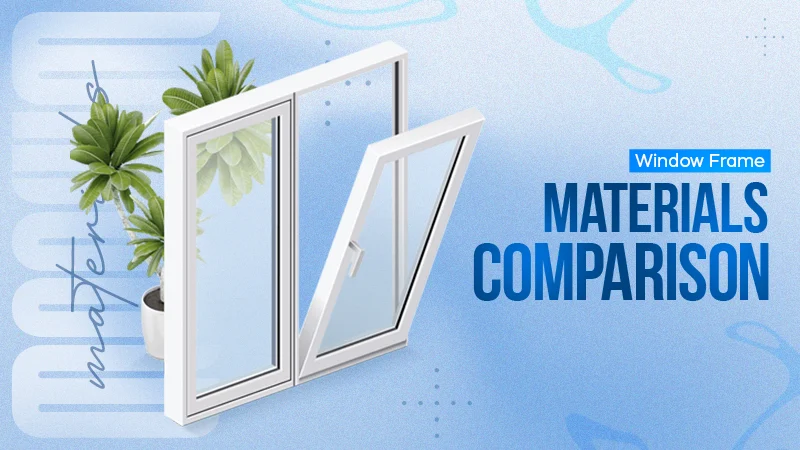Are you curious to know about the Umbrella plant? Well, this plant is one of a kind and is popular among plant lovers. While it does not shield you from the rain, it does have an umbrella-like appearance. This plant comes in several varieties and could be an ideal indoor plant for you with little maintenance.
In this article, we will take you on a journey to discover the Umbrella tree, including its characteristics, types, benefits, and more. So, let us begin the journey.
Why is It Called an Umbrella Tree?
If you are wondering why this plant is known as the Umbrella plant, the answer is simple. As the picture shows, this plant resembles an umbrella, which explains why it is known as the one.
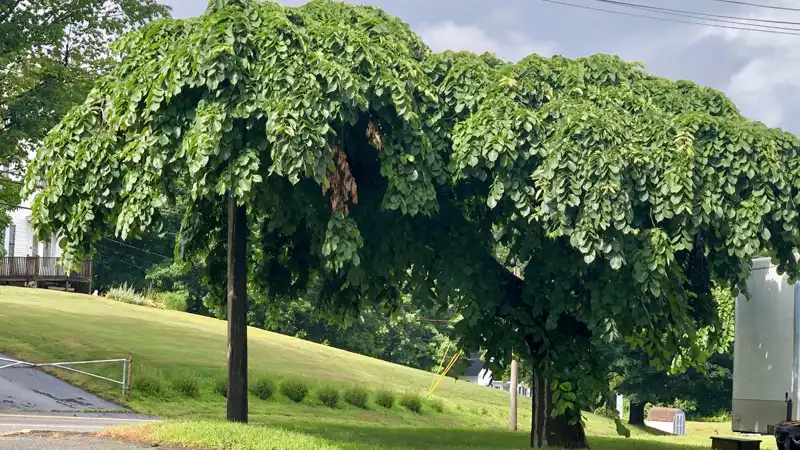
The Umbrella Tree, or Schefflera, derives its name from its large, umbrella-shaped foliage. This plant’s leaves are arranged in a circular or semicircular pattern at the top of the stem, giving the appearance of an umbrella when viewed from below. These characteristics have earned it the name “Umbrella Tree”.
Characteristics of an Umbrella Tree
Before buying an Umbrella tree, you should understand its basic characteristics. Here is the botanical information about the tree:
| Family | Araliaceae |
| Scientific Name | Cyperus alternifolius |
| Plant Type | Perennial |
| Plant Features | Broadleaf evergreen plan |
| Native Area | Taiwan, Tropical Australia, New Guinea, and Java |
| Height | 4 to 6 feet (1.83 m) indoors, up to 25 feet (ca. 8 m) outdoors |
| Bloom Time | During summer |
| Flower Color | White, pink, or red |
| Hardiness Zone | 10-12 (USDA) |
| Sun Exposure | Bright, indirect light |
| Soil Type | Rich, moderately moist soil |
| Soil pH | Slightly acidic, 6.0-6.5 pH |
| Watering | When top one inch of soil is dry |
Let us take a quick look at the basic data about the plant’s characteristics that we have organized into a categorized format.
- Growth Habit
The Umbrella plant is second to none! If properly cared for, it has the potential to grow to a reasonable height. An Umbrella tree has an average height of about 5 meters.
- Indoor Adaptability
Well, these plants have evolved in such a way that they can also survive in low-light conditions. This makes them an excellent choice for an indoor plant as well, though it is always recommended to place an umbrella plant outdoors in direct sunlight.
- Leaf Structure
The leaves are typically large, glossy, and compound, with several leaflets arranged in a semicircular or circular pattern resembling an umbrella.
- Physical Structure
These plants are extremely resilient, which makes them a good option for a humid environment. They may require additional care in areas with less rainfall, but they are extremely adaptable in other areas.
- Toxicity
Even though these plants seem benign, they can be deadly poison for your pets, so be cautious around them. A small amount of the plant may not be dangerous at first, but if your pet ingested more than two or three leaves, you should consult a veterinarian.
That is all for botany today; you have spent a good time learning boring theory. Jokes apart, we sincerely hope that after reading this, you have learned something and can apply it while planting an Umbrella tree.
Learning the Needs of the Umbrella Plant
Like any other plant, the umbrella plant also has specific requirements to flourish throughout the year. Take a look below to learn how to provide for your plant.
- Sunlight: This plant usually prefers bathing in bright indirect sunlight, which is why it is great for indoors. If kept outdoors, keep it in a place that receives 4-6 hours of filtered sunlight throughout the day.
Its leaves are quite sensitive to direct sunlight, thus remember to keep them in a sheltered area, such as a greenhouse. Rotate the plant once in a few weeks to ensure every part receives sufficient light.
- Soil: Potting soil with good drainage and lots of organic matter is ideal for umbrella plants. The ideal ratio of drainage to moisture retention can be achieved by combining peat moss, perlite, and vermiculite.
- Water: The soil should remain somewhat damp, but not drenched. Before rewatering, let the top one inch of soil dry out. This simulates the rainfall patterns that the plant would naturally encounter in its natural environment.
Lower the frequency of watering during cold weather conditions. Remember to not underwater or overwater your plant as it can cause real damage.
- Fertilization: During the growing season (spring and summer), feed the plant once a month with a balanced, water-soluble fertilizer. Reduce or stop fertilizing when the plant enters its dormant phase in the fall and winter.
To avoid fertilizer burn, water the plant before applying fertilizer. Furthermore, occasionally flush the soil with plain water to avoid nutrient imbalances and get rid of any salt buildups.
- Temperature and Humidity: The typical room temperature range for the umbrella plant is 60 °F to 75 °F (15 °C to 24 °C). Although it can withstand a little drop, it is best to keep it away from temperatures below 55 °F (13 °C), as these can cause wilting leaves or slow growth.
The umbrella plant prefers high humidity, which is not usual in homes. Try using a humidifier or setting the plant on a tray with water and pebbles. Occasionally misting the leaves will also help to raise the humidity.
Several pests like spider mites, mealybugs, and aphids can affect the plant. Thus, get rid of them instantly using the right pesticide. Moreover, the plant may also catch diseases like root rot or leaf spot due to lack of proper care. Thus, it is a must to keep track of sun exposure and watering routines.
Treating the plant with love and care is also the key to its health. Focus on your plant’s growth behavior to understand more about its needs.
Steps to Propagate an Umbrella Plant
The only method to grow an umbrella plant is by propagating it using a stem. If you wish to do so, take on the below-mentioned instructions for a safe planting:
- Choose a healthy stem from an adult plant, that has atleast two leaf nodes.
- Make a diagonal cut right below a leaf node using sterilized scissors or pruners.
- Remove the bottom leaves to make space for planting.
- Now, put the stem parlty soaked in water-filled jar till the roots grow out. Change the water once in a few days.
- Prepare a pot with proper drainage holes and fill it with suitable potting mix.
- Make a hole in the soil and place the cutting in it.
- Cover the gaps with more soil and water the plant thoroughly.
- Place the pot in a warm, sunlit and properly ventilated area.
Remember to repot your plant once in 2-3 years to maintain continuous growth. Always use a pot one sixze greater than the previous one. However, never reuse the previous soil, as it lacks proper nutrients.
3 Different Varieties of Umbrella Tree
Let’s take a look at some different types of Umbrella trees. All of those plants may not be widely distributed around the world, but they do have some distinguishing characteristics, resulting in a variety of Schefflera plants.
Learn the Difference!
The terms “species” and “genus” are often misunderstood. For example, just because two plants have different scientific names does not mean that they are from different species. In scientific names, genus and species are represented by the first and second terms, respectively.
In the following example, even though the plants have different scientific names, you can see that the first term is the same while the second term is different, indicating that the plant’s genus is the same while their species is different.
Schefflera actinophylla (Queensland Umbrella Tree)
This tree originates from Australia. It has large leaves and resembles a regular tree with a tropical feel. It is commonly found in regions like Queensland and New Guinea, where it gives the surroundings a pleasant tropical feel and a nice touch of greenery.
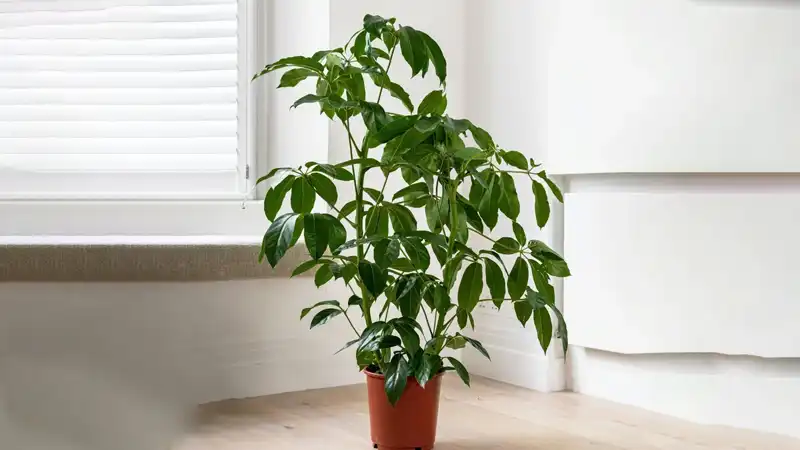
Schefflera elegantissima (False Aralia)
This plant originates in warm Asian climates. Its leaves have an elegant, lace-like appearance. Many people prefer to keep it inside their homes because it improves the appearance of rooms and adds a subtle, sophisticated touch to interior spaces.
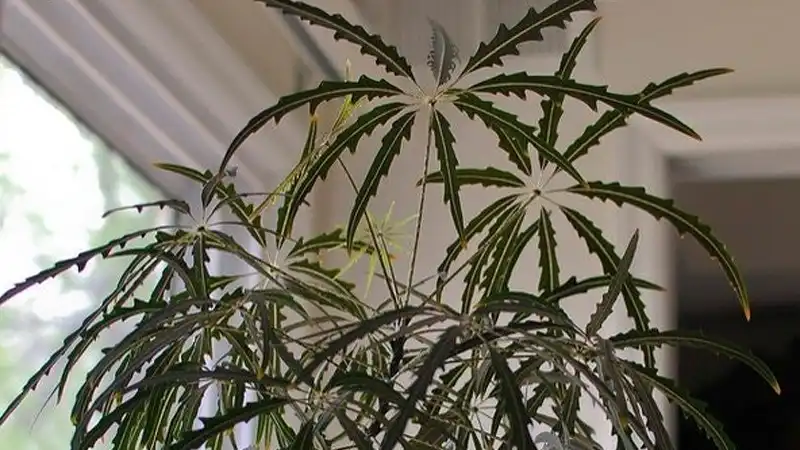
Schefflera digitata (Finger Aralia)
This plant comes from New Zealand and the surrounding islands. Its leaves are fascinating because they look like fingers. People usually grow it outside in warm places where it can display its distinctive leaf shape, making gardens more intriguing and adding a sense of mystery to the landscape.
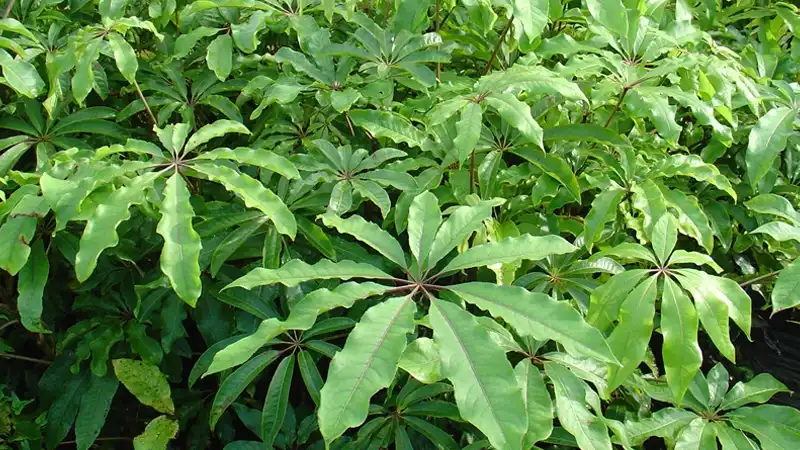
These are some of the most well-known varieties of the Umbrella tree. Other varieties may exist depending on the geographical location, but these three are the most common and thus officially recognized Umbrella plant species.
Why Keep an Umbrella Plant at your Home?
We are going to share some incredible and mind-blowing benefits of this plant. We do not think we need to explain why we think an Umbrella plant is one of the best things to have in your room. But if you still have doubts, they will vanish as soon as we discuss these reasons.
- Attractive Leaves: The leaves are shiny and attractive, adding to the beauty of rooms or gardens.
- Easy to Care: They do not require much attention, so even beginners can keep them healthy.
- Can Grow Anywhere: They can grow both indoors and outdoors, making them suitable for a variety of environments.
- Doesn’t Require Much Water: They can survive without water for a while, so you do not have to water them frequently.
- Cleans the Air: They contribute to cleaner indoor air by removing harmful contaminants.
All of these advantages, combined, make this plant an excellent choice for plant lovers. You can have a healthy and thriving Umbrella Plant that adds beauty and freshness to your indoor space by following some basic instructions.
The Best Umbrella Tree Care Tip Ever!
These plants may appear cute to some people, but they are not that soft. Consider and admire how these plants have survived for millions of years without human intervention. With this in mind, do you believe that these plants require care tips?
You might be a little disappointed, but the truth is that these plants are completely self-sufficient and do not require any care at all. You can find a ton of articles online that offer advice on how to take care of umbrella trees, but, in a nutshell, they are all useless. If you are still not satisfied, the best thing you can do is give your plant some fertilizer, dust it every day, and expose it to the sun to ensure that it grows.
In a Nutshell
If you are a beginner, the Umbrella plant may be the best choice because it requires little maintenance and can easily adapt to changing weather conditions.
Aside from its adaptability, this plant has other advantages, such as not requiring much water and cleaning the air, making it an excellent choice for all plant enthusiasts. Even though this plant is easy to grow, we recommend using some basic fertilizers to keep it fresh and healthy. Overall, these characteristics make it an excellent choice for both indoor and outdoor plants.
What is a Schefflera plant?
It is simply the umbrella tree, which is the genus name. Schefflera plants are naturally adaptable, so you may not need any additional plant care tips for them.
Where can we find Arboricola plants?
The Araliaceae family of flowering plants includes Heptapleurum arboricola, which is indigenous to Taiwan and the Chinese province of Hainan.
What is the scientific name of the Dwarf Umbrella tree?
Heptapleurum arboricola is the scientific name of this umbrella tree variety.
Heptapleurum arboricola, Wikipedia
Umbrella Tree (Document), University of Florida

